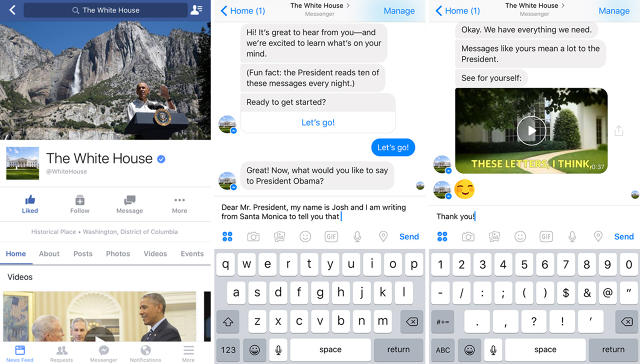The White House’s New Facebook Messenger Bot Makes It Easy To Send A Message To Obama
Today, the White House is releasing a Facebook Messenger bot that allows users to send notes to the president.
Here’s how it works: You open up the Messenger app on your phone (or the chat feature in Facebook.com) and type in “The White House” as the name of the “friend” you want to message. Alternatively, you can go to the White House’s Facebook page and click the “Message” button. Either way, a series of screens (the bot) will appear that let you fill out a message to the president. Press “send” and the message goes straight to the Office of Presidential Correspondence—the White House department that collects and processes all communications from citizens.
There’s nothing particularly earth-shattering about the bot. People have been sending messages to the president since the founding of the republic. This is just one more way to do it.

But while the bot itself might seem pretty simple, the fact that the White House is diving into Facebook bots so quickly (they were only introduced a few months ago) is a sign of how President Obama’s administration is trying to improve the workings of government for everyday citizens—and get more people to participate.
Certainly, compared to other Messenger bots in the works, the White House one doesn’t do a whole lot. Facebook launched the bots platform this spring to let brands and other organizations build mini-apps (“bots”) that are integrated directly into Messenger. The idea is to aggregate a user’s communications in a single place—rather than make them hop in and out of a bunch of apps for each brand they interact with.
Of course, Facebook also has its eye on potential revenue streams should a lot of commerce start flowing through the bots. KLM lets you get flight notifications and boarding passes inside its bot. Pizza Hut is working on one that lets you order food and keep track of promotions. Others let you check weather or order flowers. And one from the NBA featured game highlights during the league finals.
There are no such bells and whistles on the White House bot. There’s no interactivity. There are no cute features. You can only fill out a message and send it. But that’s okay, according to the bot’s creators, Jason Goldman and Josh Miller, Silicon Valley-natives-turned-White House-techies, because that’s all that was required for this particular use case.

Thousands of U.S. citizens reach out to the president every day—in the form of letters, phone calls, and emails. They share their worries about health care. They weigh in on housing policy. Some ask him to look out for their children in the military. Others let him know how he and Mrs. Obama have inspired them. The Office of Presidential Correspondence reads every single message and dispatches them to the appropriate office. “Getting very specific feedback from citizens,” Goldman told Fast Company in an exclusive interview, is “a high priority.”
“A lot of times [these messages] identify problems that might not have percolated up through the various agencies and bureaucracies,” the president was quoted as saying in a White House blog post published today. “And more than once . . . these letters inspired action on real problems.”
But it’s 2016, and people increasingly communicate digitally, rather than on paper or even by phone. So it seems natural that an institution like the White House would develop new channels to let citizens communicate via their preferred mediums. And given how many people essentially live inside social networks (Messenger has 900 million monthly users worldwide), taking advantage of the new bot platform would seem like a no-brainer.
Government agencies, however, have been notoriously slow to keep up with evolving technologies. And even when they do, they don’t always give a lot of thought to creating a great experience for users. (Need proof? Take a look at your city’s website and count how many forms are available only as PDFs.) So the fact that the White House would embrace a new technology just months after it was launched—and not go overboard with unnecessary features—is a sign of the president’s ever increasing commitment to stay in step with how people communicate today and his interest in hiring tech natives to show him how.
Goldman is one of the hundreds of people from the world of tech who have been brought to D.C. in the last few years to help government run better. (See our cover story from last year, “Inside Obama’s Stealth Startup.”) Goldman is best known as the VP of product at Twitter who shepherded the service through its formative years. He also did a stint before that at Google, working on Blogger. And after Twitter, he cofounded Obvious Corp. with Twitter’s Ev Williams and Biz Stone, to fund, incubate, and develop new startups.
Last year, President Obama asked Goldman, who has an interest in helping people engage with government, to become the White House’s first-ever chief digital officer and take over leadership of the White House Office of Digital Strategy.
The department was created soon after Obama took office, to continue the pioneering digital work his team had started during the 2008 presidential campaign. Before Goldman, the office had been run by people with backgrounds in political communications and strategy—disciplines which normally focus on how to shape and disseminate a politician’s message. Goldman is the first to come from a product management background, a field which, in the world of tech, is responsible for focusing on a product’s users—striving both to understand what they need and to create the best possible experiences for them.

Historically, a big part of the White House digital team’s work has involved creating and broadcasting content to shape the president’s narrative and drive his agenda. (Which they’ve pioneered so successfully that White House reporters have raised concerns about how social media is allowing the Oval Office to bypass the traditional media.)
The digital office is continuing with that work, but another “user” Goldman is bringing front and center are the U.S. citizens themselves. He’s interested in putting more emphasis on what he calls “a two-way conversation”—not just broadcasting to Americans, but creating useful ways for them to communicate back. “I believe civic engagement with our government is our right and our duty,” he wrote in a post on Medium last year announcing his move to the White House. All of that aligns with the mandate he received from the president: to find ways to “connect people [citizens] with purpose.” “My job,” Goldman wrote in the Medium post, “will be to use online tools to create meaningful opportunities for American citizens to participate in our government.”
The decision to create the Messenger bot came after Goldman and Miller studied traffic patterns on WhiteHouse.gov. Miller is a 25-year-old startup founder and former Facebook product manager, whom Goldman brought into the White House as director of product, another first-ever position. (They got to know each other when Obvious incubated Miller’s startup, Branch, which was acquired by Facebook in 2014.)

Studying traffic patterns is “a standard product management technique,” Goldman said. It gives you insight into what users are trying to do and how your product can best serve them. “Tech folks and people from product management have a tendency to be very data-focused,” he said. “That’s a mind-set our team has brought to the work we do here.”
While tons of pages of content had been built into WhiteHouse.gov—blog posts, videos, fact sheets—Goldman and Miller noticed that people mostly came for just two reasons: to go to the “Contact the White House” page and to fill out petitions. “If you look at where traffic is going,” Goldman said, “it’s really driven by a desire to connect.”
So when Facebook launched its bot platform this spring, a bot seemed an obvious next project. Why continue to force people to come to WhiteHouse.gov when you could just let them give feedback from inside Messenger? Building something there fit with one of Goldman’s user-focused goals: “meeting people where they are.” Based on their research, Goldman said, the team could have decided to “build some new platform” on the White House site. But it made more sense to explore options elsewhere. “We know there’s much more traffic outside WhiteHouse.gov,” he said.
Plus, they’re hoping that opening up a channel in a place where people naturally communicate with their friends could inspire more people to provide feedback to the president. “By going to new platforms,” Miller wondered, “can we get people to consider sending messages . . . who’ve maybe never done it before, or maybe never even considered it?”
Goldman has brought that product management sensibility to other projects. Back in 2011, the White House launched “We the People,” a site that lets people create and sign petitions. Once in Washington, Goldman looked under the hood and found ways to improve the user experience. He created a mobile version of the platform (“an overwhelming amount of the traffic on We the People came from phones, but earlier iterations of the site weren’t optimized for mobile,” Goldman wrote in a Medium post in April. “It’s not hard to imagine how frustrating this may have been”). They also added more information to help people figure out if their issue was something that fell within the federal government’s purview, so they wouldn’t waste their time on something the government couldn’t address.
They’ve also run Twitter chats with government officials on topics the public is interested in and brought officials to Facebook groups to answer questions on the Zika virus and opioid addiction.
Only a handful of people who use the new Messenger bot will likely hear back from the White House. That’s consistent with what happens today. Feedback gets forwarded to the appropriate agency (if it’s a plea for help) or working group (if it’s feedback on policy). In some cases, the senders get an email, letter, or phone call in return. The president himself reads 10 handpicked notes every day, and personally responds to many of them. But because of the sheer volume, many people simply make do with radio silence. “We don’t guarantee a response,” Miller said. “But we promise you we’re listening.”
Fast Company , Read Full Story
(34)














